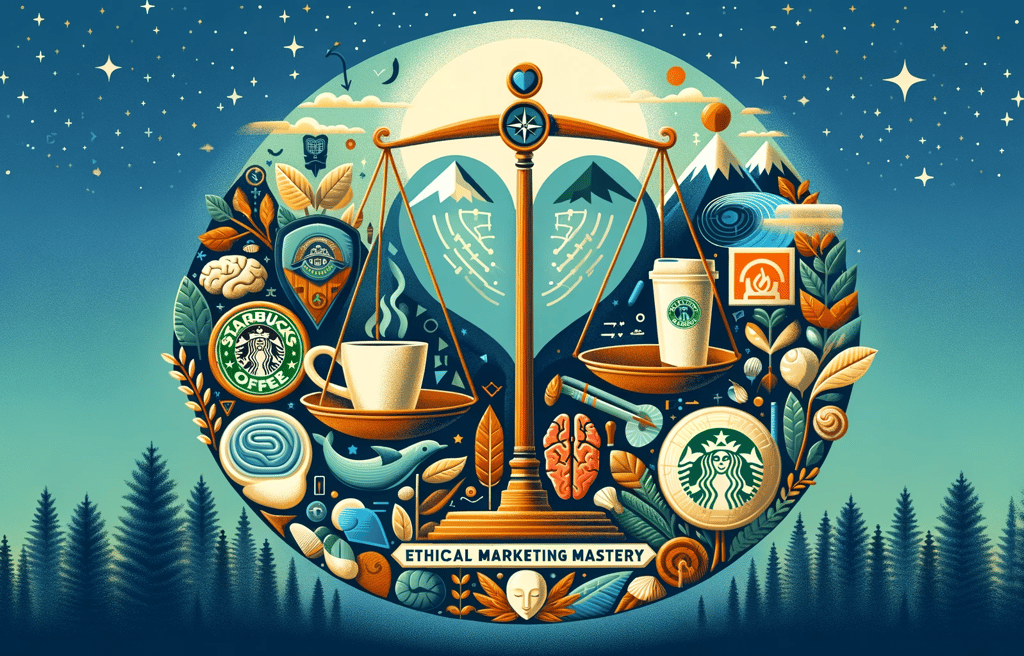Ethical Marketing in Action: Starbucks and Patagonia's Blueprint for Success
Learn how Starbucks and Patagonia use ethical marketing and environmental analysis to build successful, trusted brands. A case study in 4 key lessons.
MARKETING
The Procure 4 Marketing Team
9/21/20233 min read


Quick Answer: How do brands practice ethical marketing?
Leading brands like Starbucks and Patagonia practice ethical marketing by integrating it into their core business strategy. Starbucks demonstrates this by analyzing its marketing environment (e.g., adapting menus to local tastes and using its app for tech-savvy users) and committing to ethical sourcing (C.A.F.E. Practices). Patagonia builds its brand on radical transparency (publicly sharing its supply chain) and social responsibility (donating 1% for the Planet), proving that ethics can be a powerful competitive advantage.
Ethical Marketing: From Theory to Real-World Success
In our previous articles, we've explored the marketing environment (micro and macro factors) and the principles of an ethical marketing strategy. Now, let's see how two of the world's most successful brands put these concepts into action. Starbucks and Patagonia provide a powerful blueprint for how to navigate the market and build a beloved brand by leading with values.
Case Study 1: Starbucks - How to Analyze the Marketing Environment
Starbucks is a master at analyzing and adapting to its marketing environment. They constantly monitor both micro and macro factors to stay relevant and competitive.
Lesson 1: Adapt to the Microenvironment (Customers & Competitors)
Starbucks understands that its immediate environment is different in every city and country. They don't use a one-size-fits-all approach.
Customer Preferences: They famously localize their menus to appeal to local tastes, a key micro factor. Examples include the Green Tea Latte in Japan and the Red Bean Green Tea Frappuccino in China.
Competitors: In markets with a strong local coffee tradition (like Italy or Australia), Starbucks positions itself differently, focusing on the "third place" experience rather than just trying to compete on the taste of its coffee alone.
Lesson 2: Respond to the Macroenvironment (Technology & Society)
Starbucks has built its dominance by identifying and embracing large-scale societal trends.
Technological Factors: Starbucks saw the rise of smartphones as a macro-level opportunity. They invested heavily in their mobile app, creating an industry-leading platform for digital payments, rewards, and mobile ordering that enhances convenience and builds loyalty.
Social & Environmental Factors: Starbucks recognized the growing consumer demand for sustainability. They responded by creating their C.A.F.E. Practices for ethical sourcing and launching their "Planet Positive Future" initiative to reduce carbon emissions and waste. This aligns the brand with the values of its target audience.
Case Study 2: Patagonia - A Blueprint for Ethical Marketing
Patagonia is arguably the gold standard for ethical marketing. The company has successfully built its entire brand identity around its commitment to environmental and social responsibility.
Lesson 3: Build Your Brand on Radical Transparency
Patagonia's marketing is built on a foundation of trust and honesty, which they earn through transparency.
What they do: The company openly shares details about its supply chain, including the factories it works with and the environmental impact of its materials.
Why it works: This transparency creates a powerful bond with consumers. Patagonia even famously ran an ad titled "Don't Buy This Jacket" to raise awareness about consumerism, enhancing its credibility as an ethical brand.
Lesson 4: Make Social Responsibility Your Core Mission
For Patagonia, ethics isn't a marketing campaign; it is the company.
What they do: Through their "1% for the Planet" initiative, the company has donated 1% of its total sales to environmental non-profits for decades. Their marketing platforms are frequently used to advocate for environmental issues and social change.
Why it works: This authentic commitment to a cause greater than their own profits has built a fiercely loyal customer community. Customers feel that by purchasing a Patagonia product, they are supporting a movement they believe in.
Frequently Asked Questions (FAQ)
Q1: What is the main takeaway from these two case studies? A: The main takeaway is that analyzing the marketing environment (like Starbucks) and committing to ethics (like Patagonia) are not just "nice-to-do" activities. They are powerful, proven strategies that build brand loyalty, create a competitive advantage, and drive long-term, sustainable business success.
Q2: What is "ethical sourcing"? A: Ethical sourcing is the process of ensuring that the products or materials a company procures are obtained in a responsible and sustainable way. This includes ensuring fair labor practices, safe working conditions, and minimal environmental impact throughout the supply chain. Starbucks's C.A.F.E. Practices is a well-known example.
Q3: Can a small business afford to implement ethical marketing? A: Yes. Ethics is not about the size of your budget; it's about the values you operate with. A small business can practice ethical marketing by:
Being transparent and honest in its advertising.
Respecting customer privacy and data.
Sourcing materials from local or fair-trade suppliers.
Donating a small portion of its profits to a local community cause.

